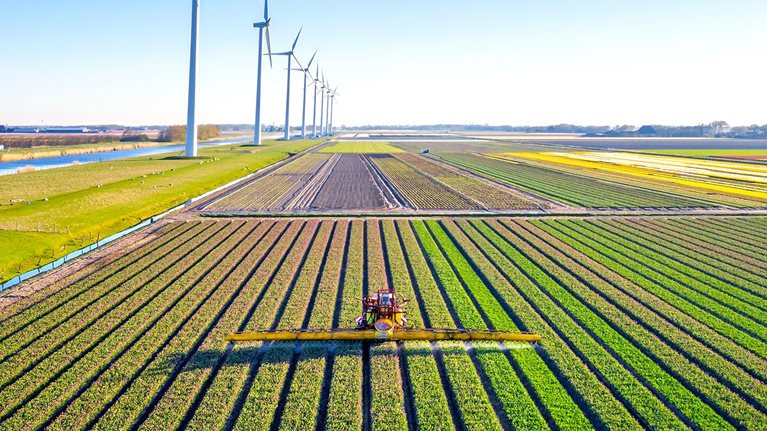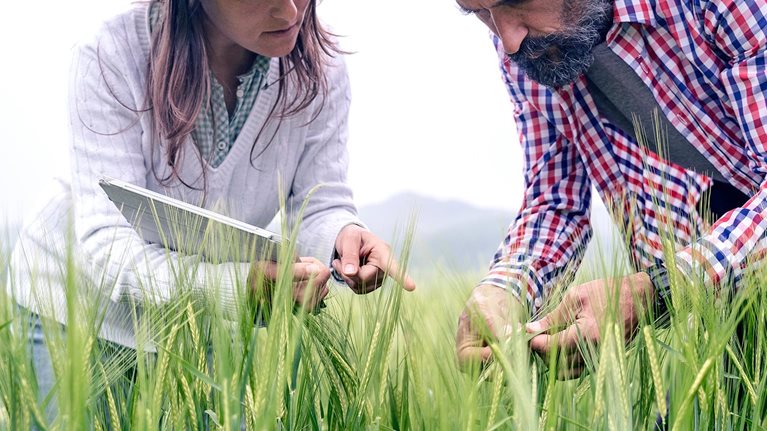Since 2018, McKinsey has gone into the field to better understand farmers’ mindsets. Following our publication of “Global Farmer Insights 2022,”1 we surveyed nearly 500 US farmers in 2023 to learn about their profitability, outlook on purchasing decisions, and adoption of sustainability practices and agtech solutions.2 The 2023 survey found that despite recent supply chain disruptions, price volatility, and inflation, many farmers are investing in adopting sustainable-farming practices and technology solutions.
The sustainable-farming environment is rapidly evolving
Sustainable-farming practices are necessary to meet decarbonization goals and broader environmental targets.3 Agriculture accounts for nearly a quarter of global emissions,4 and it was identified as the industry that contributes the most to exceeding planetary boundaries in McKinsey’s 2022 report Nature in the balance.5
Governments, investors, and companies are taking action to promote change. For example, the US Department of Agriculture’s mandatory budget in 2023 included an estimated $7 billion dedicated to conservation, with an additional $17 billion in conservation funding mandated by the Inflation Reduction Act through 2031.6 Furthermore, many agriculture players and consumer goods companies have committed to regenerative farming and deforestation-free supply chains.
However, average 2021–22 global finance flows for agriculture were only $43 billion, compared with $515 billion for energy systems and $336 billion for transport.7 And adoption of sustainable-farming practices is not increasing fast enough to meet the sustainability goals of food processors and consumer goods companies.
In 2022, we released The agricultural transition: Building a sustainable future,8 a report that examined on-farm decarbonization measures and laid out a path to meet decarbonization targets. As a part of our fourth quarter 2023 survey, we explored a selection of these and other practices to better understand farmer adoption and opportunities to scale it in the United States.
Adoption of sustainable-farming practices is growing, but penetration remains low
Although 90 percent of farmers expressed awareness of the selected sustainable-farming practices, holistic adoption remains low. While more than 68 percent of farmers surveyed have adopted reduced- or no-till practices, only about half are using variable-rate fertilizer application and 35 percent are using controlled-irrigation practices.
Sustainable-farming practices that require behavioral changes in agriculture lead the way in adoption (for example, reducing or eliminating tillage), followed by practices that require product changes, such as nitrogen stabilizers or inhibitors. Practices that require changes in equipment tend to have the lowest adoption levels (Exhibit 1).

Many farmers are adopting sustainable-farming practices, but they are implementing them on only a small share of their acreage—generally less than 30 percent. There is an opportunity to increase acreage penetration among current users, especially for practices such as cover cropping and use of biologicals.
There are further opportunities to increase overall adoption by educating farmers on newer practices and convincing farmers who have heard of but not used the practices to give them a try. For example, 74 percent of farmers said they had heard of on-farm renewable energy, but only 13 percent have adopted it and only 7 percent are planning to adopt it in the next two years. Furthermore, 16 percent of farmers said they had not heard of biologicals, and 46 percent had not heard of biochar as a fertilizer.
Specialty-crop farmers are leading the way on adoption of most sustainability practices (Exhibit 2). Adoption is at least 20 percent greater among specialty-crop farmers for half of the practices surveyed. For example, biologicals adoption is 11 percentage points higher for specialty crops than for row crops; 20 percent of specialty farmers said they have adopted on-farm renewable-energy generation compared with 11 percent of row-crop farmers. Moreover, a greater percentage of specialty-crop farmers said they plan to implement sustainability practices in the next two years compared with row-crop farmers.

Practice adoption is correlated with perceived ROI
Farmers adopting sustainable-farming practices say they expect a positive ROI. Adoption of practices is highly correlated with farmers’ perceived ROI. Practices with the highest perceived ROI, such as applying fertilizer based on soil sampling, reducing or eliminating tillage, and implementing variable-rate fertilization, also have the highest rates of adoption (Exhibit 3).

Farmers expect many of the practices to have positive long-term benefits, such as a 3 to 5 percent yield rise and higher land value. However, farmers said they expect costs to remain 1 to 3 percent higher for most practices after more than five years of adoption. The ROI on adoption of sustainable-farming practices is complex and depends on a combination of factors including crop yield, crop prices, land value, and input, labor, and equipment costs. Although farmers said they generally expect the use of sustainable-farming practices to raise their costs, they also expect this increase to pay dividends in higher crop yield, land value appreciation, and better crop pricing.
For example, surveyed farmers who grow cover crops said they are experiencing or expect to experience a 3 percent increase in crop yield, a 2 percent increase in crop prices, and a 3 percent increase in land value on average. They are also experiencing or expect to experience a 2 percent increase in input, labor, and equipment costs on average, but they expect the benefits to outweigh these costs. Notably, for some practices, such as reducing or eliminating tillage, farmers expect both revenue increases (through increased yields) and cost reductions.
There are a variety of barriers to adoption
Small and large farms face different barriers in adopting sustainable-farming practices. However, compensation is a major obstacle to implementation for farms of all sizes (Exhibit 4). For example, 51 percent of medium-size and large farms with more than 1,000 acres and 39 percent of small farms identified obtaining a market premium (higher price) for sustainably grown crops or commodities as a top barrier to adoption. Moreover, 45 percent of medium-size and large farms see generating additional revenue from sustainability assets (for example, carbon credits) as their biggest barrier to adoption. Farmers with less than 1,000 acres are far more likely than those with bigger holdings to face challenges in implementing sustainable-farming practices (for example, operational barriers).

The most attractive incentives to unlock the transition to sustainable-farming practices vary by farm size (Exhibit 5). Representatives of medium-size and large farms with more than 1,000 acres said that certainty on operational benefits and reliable information on expected ROI are key. On the other hand, small farms with less than 1,000 acres highlighted the availability of financial incentives and assurance of a green premium (higher price) as the top two factors necessary to promote adoption. Overall, farmers are focused on gaining confidence in the economic benefits of sustainable-farming practices before making the full transition.

Across the board, both small and large farmers highlighted crop and commodity premiums from buyers of sustainable crops as the most attractive financial lever to increase adoption of sustainable-farming practices. Generating long-term and reliable sources of economic benefit may be key to driving additional adoption.
Government programs have seen greater participation than industry programs
Government-led programs designed to boost adoption of sustainable practices have substantially greater participation among farmers than industry programs do. These initiatives, such as the Environmental Quality Incentives Program (EQIP), are helping to spur adoption among farmers.
Of surveyed farmers, 57 percent said they were participating in a government program, while only 4 percent were participating in an industry-sponsored program, including the more than 15 carbon programs launched since 2016.9 Adoption of sustainable-farming practices was at least 20 percent greater among government program participants than among those not enrolled in any program for ten of the 13 surveyed practices (Exhibit 6). This could indicate that government programs are driving adoption and that continued programmatic support from governments and industry players may encourage more farmers to transition to sustainable-farming practices.

Industry players can take steps to support farmers
As the importance of sustainable-farming grows, winning players will partner with farmers to support them in growth and innovation. To do so, industry participants could consider the following:
- reassessing the share of value captured by the farmer and bringing transparency to consumers about the “true cost of food”
- building sustainability programs and making them accessible; practice adoption is higher among participants in programs, but most of these are small scale today
- investing in education to help farmers overcome operational challenges and generate further data points on yield and cost benefits, especially for less-adopted practices
- collaborating with smaller and specialty-crop farmers in the near term, as these farmers are more willing to adopt most practices in the next two years
- continuing to evolve and grow nutrient-related programs, such as applying variable-rate fertilizer; most farmers view these practices as ROI positive, but only about half have adopted them and only in a part of their acreage
Many agriculture players are making commitments to sustainable farming in response to the sector’s large emissions footprint. But the transition to sustainably produced food depends on changing farmers’ behaviors and operational decisions. Our survey suggests that agriculture ecosystem players should consider how they can meet farmers’ expressed need for compensation for investments in sustainable-farming practices and provide reliable information about practice implementation and operational benefits.

